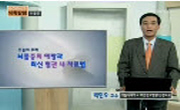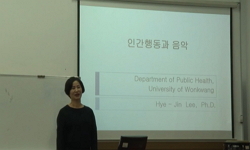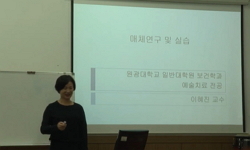본 연구의 목적은 치료적 악기 연주(TIMP)를 적용한 음악치료가 뇌졸중 환자의 하지 정적·동적 균형에 미치는 영향을 알아보기 위한 것이었다. 이에 대한 연구문제는 “치료적 악기 연주를 ...
http://chineseinput.net/에서 pinyin(병음)방식으로 중국어를 변환할 수 있습니다.
변환된 중국어를 복사하여 사용하시면 됩니다.
- 中文 을 입력하시려면 zhongwen을 입력하시고 space를누르시면됩니다.
- 北京 을 입력하시려면 beijing을 입력하시고 space를 누르시면 됩니다.
치료적 악기연주(TIMP)를 적용한 음악치료가 뇌졸중 환자의 하지 정적·동적 균형에 미치는 영향 = The Effects of Music Therapy Using Therapeutic Instrument Performance (TIMP) on Stroke Apoplexy Patients’ Static and Dynamic balance of the Lower Limbs
한글로보기https://www.riss.kr/link?id=T11113903
- 저자
-
발행사항
서울 : 명지대학교 사회교육대학원, 2008
-
학위논문사항
학위논문(석사) -- 명지대학교 사회교육대학원 , 음악치료학과 음악치료전공 , 2008. 2
-
발행연도
2008
-
작성언어
한국어
-
주제어
치료적 악기연주(TIMP) ; 음악치료 ; 하지 정적. 동적 균형 ; 뇌졸중
-
발행국(도시)
서울
-
형태사항
ix, 108p. ; 26cm
-
일반주기명
지도교수 :문소영
- 소장기관
-
0
상세조회 -
0
다운로드
부가정보
국문 초록 (Abstract)
본 연구의 목적은 치료적 악기 연주(TIMP)를 적용한 음악치료가 뇌졸중 환자의 하지 정적·동적 균형에 미치는 영향을 알아보기 위한 것이었다. 이에 대한 연구문제는 “치료적 악기 연주를 적용한 음악치료가 하지 정적 균형에서 발바닥의 압력 점수·균형감각에 유의미한 차이가 있는가"와 "하지 동적 균형에서 발의 각도·보행 패턴에 유의미한 차이가 있는가"로 설정하였다.
연구의 대상은 서울 송파구에 위치한 Y병원 재활 의학과에 뇌졸중으로 입원 중인 좌측 혹은 우측의 편마비를 가진 5명의 환자였다. 연구기간은 2007년 9월 3일부터 10월4일까지 4주간에 걸쳐 총 12회(주 3회, 35분간)로 음악치료를 실시하였다. 연구 설계는 다른 치료(물리치료, 작업치료)들만 적용되는 음악치료 비 중재기간 3일(A)과 음악치료 중재기간 3일(B) 사이에서 유의미한 차이가 있는가를 알아보기 위하여 ‘ABABABAB’로 설계하였다. 본 연구는 신경학적 음악치료 방법의 하나인 TIMP를 적용한 음악치료 프로그램을 계획하여, 각 세션을 ‘준비운동(PSE), TIMP를 적용한 악기연주, 정리/완화 운동, Feed back’으로 구성하였다. A와 B 각각의 중재 후 바로 하지 균형을 측정하였고, 정확한 측정을 위하여 ‘Foot Scan’을 사용하였다.
본 연구에서는 음악치료 중재에 대한 대상자의 변화를 비교하기 위하여 ‘발바닥의 압력 점수’와 ‘균형 감각’, ‘발의 각도’와 ‘보행 패턴’의 측정 결과를 Microsoft Excel 2000 프로그램을 이용하여 표와 그래프·그림으로 정리하였다.
연구의 결과는 다음과 같다.
첫째, 대상자들의 발바닥 압력 점수는 음악치료 비 중재(A)와 음악치료 중재(B)의 관계는 불규칙하게 나타났지만, 사전 측정(A¹)보다 사후 측정(B⁴)에서 감소되었다.
둘째, 대상자들의 균형 감각은 A와 B의 차이값이 불규칙적으로 변화되었기 때문에 음악치료가 대상자에게 긍정적인 영향을 주었다고 단언하기는 어렵다.
셋째, 대상자들의 발의 각도는 발바닥 압력 균형이 정상적으로 이루어지지 않은 전제하에 발의 각도 또한 일직선으로 이루어지지 않음을 알 수 있었다.
넷째, 대상자들의 보행 패턴은 입각기에서 유각기로의 패턴을 훈련하도록 하였다. 대상자들의 경직된 상태에 따라서 다르지만, 뇌졸중 환자의 보행 특성상 건측으로 빨리 이동하고자, 환측의 입각기와 건측의 유각기가 짧아짐을 볼 수 있었다. 그러므로 건측 발은 발 뒤꿈치가 지면에 닿지 않고 발끝으로 닿게 되는 것이다.
본 연구는 임상 연구 기간이 짧고, 치료적 악기연주로 쓰인 악기의 안정성 고려와 악기의 배치가 일관성이 없었다는 제한점을 가진다. 그러나 본 연구에서 시행된 TIMP를 적용한 음악치료는 뇌졸중 환자의 하지 균형 변화에 긍정적인 효과를 보여주었다. 따라서 본 연구는 뇌졸중 환자의 재활 치료로서 TIMP를 적용한 악기연주가 하나의 적용방안으로 사용될 수 있는 것을 확인한데 의의를 가진다. 본 연구의 결과를 바탕으로 한 후속연구에서는 재활치료로서의 음악치료가 다양한 악기를 사용하여 접근해 보기를 기대한다.
다국어 초록 (Multilingual Abstract)
The objective of the present study is to examine the effects of music therapy using therapeutic instrument performance (TIMP) on cerebral apoplexy patients’ static and dynamic balance of the lower limbs. For this purpose, we formulated research ques...
The objective of the present study is to examine the effects of music therapy using therapeutic instrument performance (TIMP) on cerebral apoplexy patients’ static and dynamic balance of the lower limbs. For this purpose, we formulated research questions: “Does music therapy using therapeutic instrument performance make a significant difference in the pressure score and balance sense of the sole of the foot in the static balance of the lower limb?” and “Does music therapy using therapeutic instrument performance make a significant difference in foot angle and walking pattern in the dynamic balance of the lower limbs?”
The subjects of this study were 5 patients with hemiplegia on the right or left side who were admitted for cerebral apoplexy to the Rehabilitative Medicine Department of Y Hospital at Songpa?gu, Seoul. Music therapy was executed a total of 12 sessions (3 a week and 35 minutes per session) during four weeks’ research period from the 3rd of September to 4th of October, 2007. This research was designed ‘ABABABAB’ in order to see if there was a significant difference between 3 days’ music therapy non?intervention periods (A) when only other treatments (physiotherapy, occupational therapy) were applied and 3 days’ music therapy intervention periods (B). This study planed a music therapy program adopting TIMP, one of neurological music therapy methods, and each session was composed of warming?up exercise (PSE), instrument performance using TIMP, finishing/relaxing exercise, and feedback. After each intervention of A or B, lower limb balance was measured immediately, and ‘foot scan’ was used for accurate measuring.
In this study, we presented the results of measuring ‘the pressure score of the sole of the foot,’ ‘balance sense,’ ‘foot angle’ and ‘walking pattern’ in table, graph and picture using Microsoft Excel 2000. The results of this study are as follows. First, the subjects’ pressure score of the sole of the foot changed irregularly in music therapy non?intervention (A) and music therapy intervention (B) but it decreased in the posttest (B⁴) compared to that in the pretest (A¹). Second, the subjects’ balance sense changed irregularly in A and B, so it is hard to assert that the music therapy had a positive effect on the subjects. Third, subjects’ foot angle was not straight on the assumption that the pressure balance of the sole of the foot was not normal. Fourth, subjects’ walking pattern was trained to be changed from the stance phase to the swing phase. Although different depending on the subjects’ stiffness, the stance phase of the affected side and the swing phase of the unaffected side were shortened for fast switch to the unaffected side as a characteristic of cerebral apoplexy patients’ walking. Therefore, the foot on the unaffected side landed on its tiptoe before the heel touched the ground.
This study has limitations such as a short period of clinical research, the instability of instruments used in therapeutic instrument performance, and inconsistency in the arrangement of instruments. However, the music therapy using TIMP executed in this study showed a positive effect in improving cerebral apoplexy patients’ lower limb balance. Accordingly, this study is meaningful in that it confirmed the applicability of instrument performance using TIMP as a rehabilitative treatment for cerebral apoplexy patients. Based on the results of this study, we expect subsequent research approaching music therapy as a rehabilitative treatment using various instruments.
목차 (Table of Contents)
- 그림목차 = ⅳ
- 표목차 = ⅶ
- 국문초록 = ⅷ
- Ⅰ. 서론 = 1
- A. 연구의 필요성 = 1
- 그림목차 = ⅳ
- 표목차 = ⅶ
- 국문초록 = ⅷ
- Ⅰ. 서론 = 1
- A. 연구의 필요성 = 1
- B. 연구의 목적 = 4
- C. 연구 문제 = 5
- D. 연구 용어 정의 = 6
- Ⅱ. 이론적 배경 = 7
- A. 뇌졸중 = 7
- 1. 정의 및 변인 = 7
- 2. 동반되는 장애 = 9
- 3. 뇌졸중과 하지 균형 = 11
- B. 뇌졸중 재활 = 14
- 1. 뇌졸중 재활 프로그램 = 14
- 2. 재활 전략 = 17
- C. 신경학적 음악치료 = 19
- 1. 뇌졸중 재활 음악치료 = 19
- 2. 신경학적 음악치료 = 20
- 3. TIMP를 적용한 음악치료 = 25
- Ⅲ. 연구방법 = 27
- A. 연구 대상 = 27
- B. 연구 설계 = 28
- C. 연구 절차 = 30
- 1. 연구 기간 및 절차 = 30
- 2. 사용된 도구 = 33
- D. 측정도구 = 35
- 1. Foot Scan = 35
- E. 데이터 분석 = 36
- Ⅳ. 연구결과 = 37
- Ⅴ. 결론 및 논의 = 73
- A. 논의 = 73
- B. 결론 = 74
- 참고문헌 = 76
- Abstract = 82












